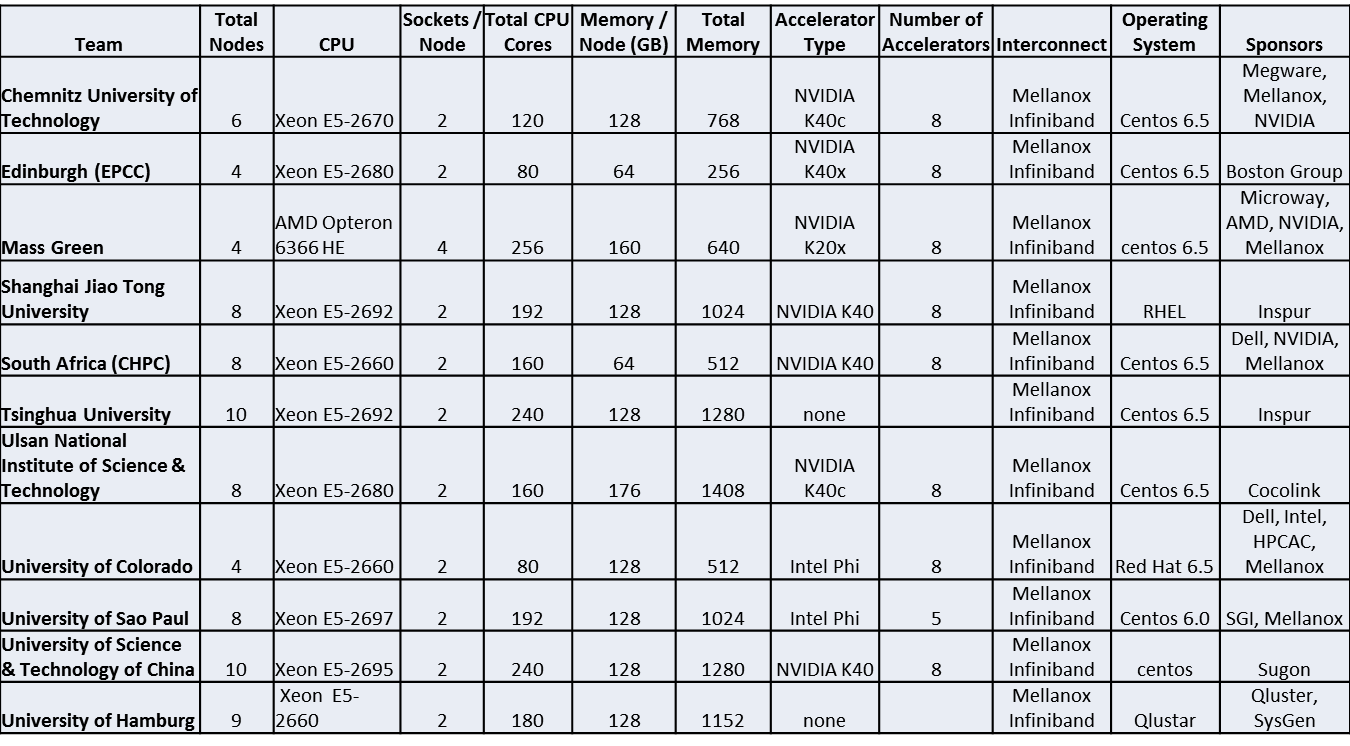Let’s look at what the teams were running at the ISC’14 Student Cluster Competition. This year we had perhaps the widest variety of systems in terms of size, and also an entirely new configuration that we hadn’t seen in any competition to date.
The Mass Green team, with students from MIT, Bentley University, and Northeastern University, broke Team Boston tradition with their quad-socket, core-laden, monster cluster. To maximize CPU core count they went with 16-core AMD Opteron processors. (Full table with all team configurations below.)
(Click to enlarge.)
The result was a competition-topping 256 CPU cores, which is considerable. But, in typical Mass Green style, they didn’t stop there. They also added eight NVIDIA K20x (low profile) GPUs into the mix. However, they only had 640 GB of memory, which may have hurt on some of the apps.
I think that they might be onto something here. Using quad-socket boards will keep more of the processing local to the node, reducing or eliminating the hops needed to process some of the tasks.
However, this might be a better approach at a competition like SC, where the teams run multiple applications at once. At the ISC competition, teams typically only work on one app at a time, putting less of a premium on application placement.
Small Is Beautiful; Or Is It?
On the “small is beautiful: side of the ledger, both Edinburgh and Colorado used four traditional dual-socket nodes. Colorado, due to the power cap and a twitchy PCIe slot, used only three of their nodes during the actual trials. This allowed them to run with dual Intel Phi co-processors on each node.
Edinburgh took the NVIDIA road, sporting eight K40x GPU cards. They also had another trick up their sleeve – liquid cooling. Working with their Boston Group sponsor, Team Edinburgh was driving a four-node, liquid-cooled cluster, with only 80 CPU cores and the lowest main memory in the bunch (256 GB).
They were obviously relying on added punch from their GPUs. This was expected to help them nail LINPACK, but would this system perform well on the scientific applications? Also, would liquid cooling give them enough thermal headroom to push their undersized system to the point where they could outperform the larger systems?
How about some old school?
Team Tsinghua, a veteran team and former ISC Champion, brought a ten-node cluster with 240 CPU cores and 1.25 TB of RAM to the competition. One thing missing from their configuration? Accelerators.
Tsinghua was one of the first teams to effectively use GPUs but eschewed them in their ISC’14 rig, despite riding a brace of NVIDIA K40s to a second-place finish at China’s ASC14 competition just a few months ago.
The team told me that they weren’t able to get their hands on GPUs in time for the trip to Germany, but that they hoped to make up for the deficit in number-crunching power by having more CPUs in their box, and doing a better job of tuning their cluster for the HPC apps.
Newbie team Hamburg also went the old-school route. Their nine-node cluster is crammed into a ruggedized case on wheels. To me, the case looked like something a professional polka band might use to transport their accordions on a long, multi-country tour. But it did an admirable job of holding all of their gear, and it’s optimized for a quick getaway as well.
Team Hamburg is the only team using Qlustar (pronounced “clue-star”) as their cluster operating system. They tout it as a quick and easy, yet powerful, o/s that makes setting up and managing HPC clusters a walk in the biergarten. You can check Qluster out here (https://www.qlustar.com/).
Coffee Table of Doom 2.0
The other German team, Chemnitz University of Technology, went back to the drawing board after their first Coffee Table of Doom cluster (four workstations crammed with a grand total of 16 accelerators) proved to suck up way too much power to be competitive. Coffee Table of Doom 2.0 includes six workstations, each with 128 GB RAM, plus 8 NVIDIA K40c accelerators scattered around. The team should be able to keep this system under the 3,000 watt power cap, unlike its predecessor.
The Sweet Spot?
The rest of the 11 team field sported similar systems, chock full of Xeons, accelerators, and plenty of memory.
Team Brazil (University of Sao Paulo) picked up SGI as a sponsor for their trip to ISC and also upped their configuration considerably from what we saw at ASC14. In Leipzig they drove an eight-node, 192-core cluster packed with a terabyte of RAM and five Intel Phi co-processors. Unlike their outing in Guangzhou, this should be enough hardware to allow the team to hang with the big boys.
Team South Korea, from the Ulsan National Institute of Science and Technology, also put together a larger system than they used at ASC14 last spring. We also see that the team has had a change of heart regarding accelerators. In their ASC14 competition system, UNIST used six nodes with five NVIDIA Titan GPUs. At ISC’14 they’re coming with eight beefy nodes plus eight NVIDIA Tesla K40c GPUs. This should work out better for them, I suspect.
The third team from China, the University of Science & Technology of China, has the biggest Chinese system with 10 nodes, 1.28TB of memory, and eight NVIDIA K40c GPUs. The team is sponsored by Sugon, which seems to be the public face of Chinese computing powerhouse Dawning.
According to the team, they’ve received not only a lot of hardware from Sugon, but also plenty of technical help and expertise. It’ll be interesting to see how this team does not only in the overall competition but against the other Chinese teams, who are sponsored by another very large Chinese computing company, Inspur.
Former Champs Clash
Team South Africa, the returning ISC’13 champ, and Team Shanghai, the recent ASC14 winner, are both considered favorites to take the Overall Champion crown at ISC’14. South Africa has an eight-node, 160-core cluster with eight NVIDIA K40c accelerators. Shanghai also has eight nodes, but is using a 12-core Xeon, giving them 192 total CPU cores in their system. Shanghai is also running eight NVIDIA K40c accelerators.
Another key difference between the two is memory. Shanghai, with a terabyte of RAM, is sporting twice the 512 GB memory of the South Africa cluster. As one long-time cluster observer put it, “More memory is more better.”
Posted In: Latest News, ISC 2014 Leipzig
Tagged: supercomputing, Student Cluster Competition, HPC, ISC 2014, Configurations


danolds
·
RT @HPC_Guru: #ISC14 Student Cluster Configs – by @danolds http://t.co/Wd8lWoDZq6 #HPC @ISChpc @hpccouncil via @Student_C_C
danolds
·
RT @Student_C_C: #ISC14 Student Cluster Configs http://t.co/ZCMv4G1us5 Nobody brought a knife to this gunfight #HPC @ISChpc @hpccouncil #SC…
pvanheus
·
RT @Student_C_C: #ISC14 Student Cluster Configs http://t.co/ZCMv4G1us5 Nobody brought a knife to this gunfight #HPC @ISChpc @hpccouncil #SC…
ISChpc
·
RT @HPC_Guru: #ISC14 Student Cluster Configs – by @danolds http://t.co/Wd8lWoDZq6 #HPC @ISChpc @hpccouncil via @Student_C_C
HPC_Guru
·
#ISC14 Student Cluster Configs – by @danolds http://t.co/Wd8lWoDZq6 #HPC @ISChpc @hpccouncil via @Student_C_C
ISChpc
·
RT @Student_C_C: #ISC14 Student Cluster Configs http://t.co/ZCMv4G1us5 Nobody brought a knife to this gunfight #HPC @ISChpc @hpccouncil #SC…
Student_C_C
·
#ISC14 Student Cluster Configs http://t.co/ZCMv4G1us5 Nobody brought a knife to this gunfight #HPC @ISChpc @hpccouncil #SC14